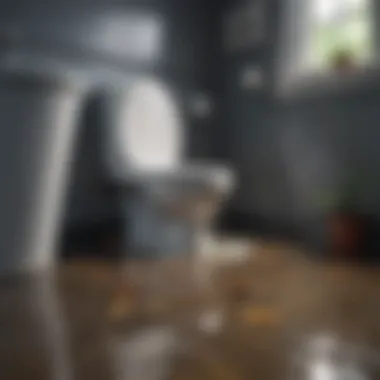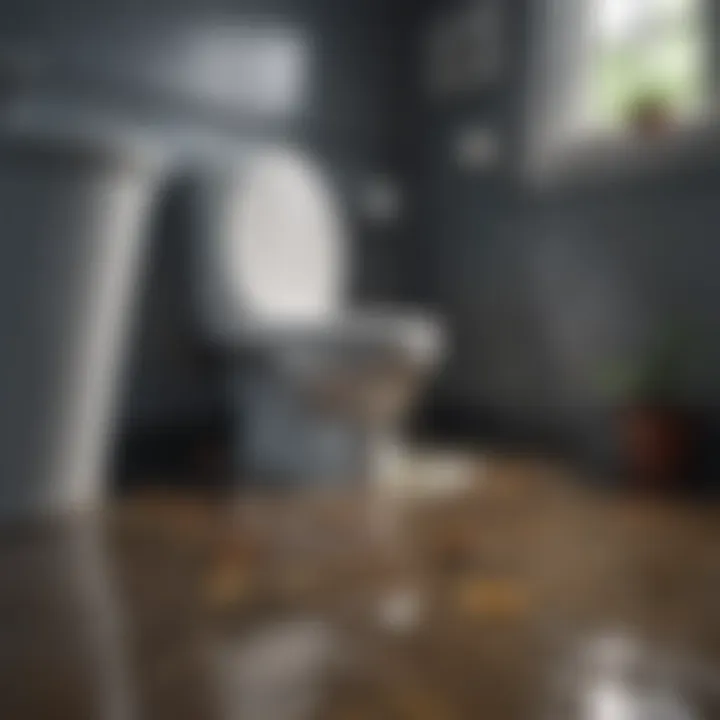Unclogging a Flooded Toilet: Expert Techniques


Intro
Dealing with a flooded toilet can be a distressing experience for any homeowner. It is crucial to understand that this often occurs due to various reasons like a blocked drain, mishandled flushing, or even an overflow from the tank. Immediate action is necessary to mitigate potential damage. This guide will explore effective techniques and considerations for unclogging a flooded toilet. In addition, we will address the tools required and some preventive measures to protect your bathroom from such incidents in the future. Understanding these aspects not only ensures you have the knowledge needed during an emergency but also promotes good maintenance practice, safeguarding your home.
Understanding the Nature of Toilet Clogs
Toilets often clog due to improper disposal of items such as paper towels, wipes, or non-biodegradable materials. Recognizing what can and cannot be flushed is essential. Frequent clogging can indicate deeper plumbing issues that might require professional intervention.
Common Causes of Flooding
- Overuse of toilet paper
- Flushing foreign objects
- Malfunctioning toilet parts
- Blocked or damaged pipes
The Importance of Immediate Action
When faced with a flooded toilet, it is vital to act swiftly. Delay could lead to water damage in surrounding areas, mold growth, or costly repairs. In the event of a flood, taking the time to identify the cause helps you choose the right method to address the problem effectively.
Techniques for Unclogging a Toilet
Here are some practical techniques that can help you deal with a flooded toilet:
1. Plunging the Toilet
Using a toilet plunger is often the first step in unclogging a toilet. A good plunger creates a strong seal and helps dislodge blockages.
- Ensure the plunger fits well over the drain hole.
- Push down and pull up firmly, maintain a good rhythm for several cycles.
2. Using a Toilet Auger
If plunging does not resolve the issue, a toilet auger may help reach deeper clogs that a plunger cannot. This tool breaks up stubborn obstructions and allows for better drainage.
"Always remember to wear gloves. Sanitation is vital when dealing with plumbing issues."
3. Baking Soda and Vinegar
For a more natural approach, a mixture of baking soda and vinegar can assist with minor clogs. Pour one cup of baking soda followed by one cup of vinegar into the toilet. Let it sit for at least 30 minutes before flushing with hot water.
Tools Required
Several tools can facilitate the process of unclogging a flooded toilet:
- Toilet plunger
- Toilet auger
- Bucket
- Rubber gloves
- Old towels or rags
- Baking soda and vinegar (optional)
Preventive Measures
To reduce the likelihood of future toilet flooding, consider the following preventive measures:
- Always check what is being flushed.
- Regular maintenance of plumbing fixtures.
- Routine inspections for signs of wear in the toilet and related plumbing.
Ending
Unclogging a flooded toilet requires understanding the problem, acting fast, and having the right tools at your disposal. By mastering these techniques and knowing preventive measures, you can not only address immediate issues but also minimize the risk of recurrence. This guide serves as a foundation for maintaining the integrity of your home's plumbing, ensuring that minor issues do not escalate into major problems.
Understanding Toilet Flooding
To truly tackle the issue of toilet flooding, it is vital to understand why it occurs. Recognizing the nuances of toilet flooding can significantly reduce stress and prevent costly damages in your home. Each component of this understanding plays a crucial role in addressing flooding effectively and ensuring that your bathroom continues to function smoothly.
Engaging with the underlying causes of flooding enables homeowners to take preventive measures. Knowledge also helps in determining when to take immediate action versus when to call for professional assistance. Therefore, familiarizing oneself with the common causes and signs of a flooded toilet will aid in swift problem resolution.
Common Causes of Toilet Flooding
Toilet flooding can arise from a variety of issues. Here are some of the most common causes:


- Clogged Drain: One of the primary culprits is a clogged drain. This may occur from the accumulation of waste material, toilet paper, or foreign objects that should not be flushed.
- Damaged Flapper: The flapper is a critical component that regulates water flow from the tank to the bowl. If damaged, it can lead to overflows.
- Malfunctioning Fill Valve: If the fill valve fails to stop water from entering the tank, it can cause the toilet to overflow.
- Sewer Line Obstructions: Sometimes, the issue may not stem from the toilet itself but from blockages in the main sewer line, significantly affecting multiple plumbing fixtures.
Understanding these causes helps in preventing future incidents by promoting proper usage and maintenance practices.
Signs of a Flooded Toilet
Identifying a flooded toilet quickly can mitigate damage and restore function. Watch for the following signs:
- Water Accumulation Around the Base: Any signs of water pooling around the base of the toilet indicate a potential flooding issue.
- Unusual Sounds: Gurgling noises coming from the toilet or plumbing can signal a blockage downstream.
- Frequent Clogs: If the toilet frequently backs up, this is a clear indication that a serious problem may be developing.
- Slow Drainage: If water does not drain as it should, this could be a precursor to more significant flooding issues.
Recognizing these signs early allows homeowners to act swiftly, reducing potential damage and costs associated with a flooded toilet.
Immediate Steps to Take
Addressing a flooded toilet requires immediate attention to prevent further damage and inconvenience. This section provides foundational actions that every homeowner should take upon discovering a clogged toilet. The relevance of these steps lies in their ability to mitigate potential damage and importantly, to restore functionality. Responding quickly not only saves the bathroom from becoming a larger disaster but also reinforces a proactive attitude towards plumbing issues.
Assessing the situation is crucial.
Assessing the Situation
Before diving into any remedial actions, it is vital to evaluate the severity of the flooding. Check the extent of the overflow— is it just a small puddle or a more significant deluge? Determine whether the toilet itself is still operational or if it has ceased to flush entirely. Inspect other bathroom elements, such as sinks or bathtubs, to identify if there are signs of additional plumbing problems. Documenting and understanding these initial conditions can inform your approach and decisions in subsequent steps.
In your evaluation, consider the possible causes behind the flooding. This can help you pinpoint the issue more effectively. Remember, merely reacting to the water does not solve underlying plumbing concerns.
Shutting Off the Water Supply
Once you have a clear understanding of the situation, the next crucial step is shutting off the water supply. Preventing further water from entering the toilet system is essential to avoid exacerbating the flooding situation. Locate the shut-off valve, typically found behind the toilet near the floor. It may require a simple twist to the right, but if the valve is stuck or corroded, you might need to use a wrench with care.
Shutting off the water not only curtails the immediate risk of flooding but also grants you the time needed to attempt unclogging methods. It stands as a critical line of defense that safeguards your home from possible water damage, mold growth, and toilet malfunctions.
Tools Required for Unclogging
Dealing with a flooded toilet requires the right tools to execute an effective resolution. Having the appropriate tools can make the process smoother, more efficient, and less messy. Properly equipped, individuals can tackle clogs with confidence, reducing the frustration associated with flooded bathrooms. Understanding which tools to use can distinguish between a minor inconvenience and a larger plumbing issue.
Basic Tools for the Task
Plunger
The plunger is perhaps the most recognized tool for unclogging toilets. Its simple yet effective design allows for forced air to push obstructions through the plumbing system. Its primary characteristic is the rubber suction cup at the base, which creates a seal on the toilet drain.
A plunger is a beneficial choice for this task due to its accessibility and affordability. It can be found in nearly any hardware or home improvement store. Furthermore, it does not require special skills to use—almost anyone can operate it.
One unique feature of the plunger is its versatility; it can handle various types of clogs, whether they are soft blockages like toilet paper or hard ones. However, the disadvantage is that it may not work for severe clogs deeper in the plumbing system.
Auger
The auger, or plumbing snake, is another essential tool when dealing with stubborn clogs. It consists of a long, flexible metal wire with a coiled end that can reach into drain pipes and remove debris. The notable feature of an auger is its ability to reach clogs that a plunger cannot.
This tool is especially valuable for its mechanical advantage, allowing it to go further into the plumbing to remove blocks. Its effectiveness makes it a popular choice among both homeowners and professionals alike. However, the use of an auger requires a bit more knowledge to operate correctly, which could deter some users.
Bucket
A bucket may seem like a simple tool, but it plays an important role in unclogging a flooded toilet. Should a flush result in overflow, a bucket is necessary to manage excess water effectively. It provides a means to transfer water safely without causing more mess.
Its key characteristic is the large volume it can hold, allowing users to remove significant amounts of water from the toilet bowl. A bucket is not just functional but also essential during the initial assessment of a flooding situation. Although there's no major downside, its effectiveness relies heavily on the user's ability to use it properly, limiting its utility in complex clog situations.
Optional Tools for Severe Cases
Drain Snake
For serious clogs that resist basic tools, a drain snake can prove invaluable. It is designed specifically to reach deeper blockages in pipes that other tools might not manage. The main characteristic of a drain snake is its length and flexibility, which allows it to navigate bends in plumbing.
It is a beneficial option in severe cases, especially when conventional methods fail. The unique feature of a drain snake is its ability to extend into pipes several feet where trouble spots might lurk. On the downside, it does require careful handling, as improper use can lead to damage in the plumbing system.


Wet/Dry Vacuum
A wet/dry vacuum can be particularly useful for removing large volumes of water quickly and efficiently. This tool is built to handle both liquid and solid waste, making it ideal for a flooded toilet scenario. Its versatility is its strongest characteristic, as it can also help in various cleaning tasks around the home.
Using a wet/dry vacuum is a beneficial choice for thorough cleanup. Its unique feature lies in its suction power, offering the capability to eliminate water swiftly, which is often crucial during a flooding event. However, it is best suited for emergencies and may require more investment compared to the basic tools already mentioned.
Utilizing the right tools can make all the difference when addressing a flooded toilet, ensuring both efficiency and effectiveness in the process.
Unclogging Methods
Unclogging methods are essential tactics for resolving the common issue of toilet flooding. A successful unclogging session can not only save time and effort but also minimize damage to your bathroom and plumbing system. Each method varies in effectiveness based on the severity of the clog, the nature of the obstruction, and the tools available. Understanding these methods equips homeowners to handle emergencies confidently. The practical aspects of each method will be discussed, along with the benefits and considerations relevant to choosing the right one.
Using a Plunger Effectively
The plunger is a basic yet crucial tool in the arsenal for unclogging toilets. Using a plunger effectively involves more than merely pushing it down and pulling it back up. To start, ensure that you have a flange plunger, as it is specifically designed for toilets. Before plunging, confirm that there is enough water in the bowl to cover the plunger. This water acts as a barrier, enhancing suction and creating the necessary pressure to dislodge the clog.
- Positioning: Position the plunger over the drain hole, ensuring a tight seal.
- Pressure: Push down slowly without breaking the seal, allowing air pressure to build. Then, pull up quickly to create a vacuum.
- Repetition: Repeat the push-pull action for 15 to 20 seconds.
- Check: Finally, check if the water level starts to drop. If it does, the clog may be clearing. If not, further methods might be required.
Employing an Auger
An auger, also known as a toilet snake, is a more advanced tool designed for deeper clogs that a plunger cannot reach. It consists of a long, flexible wire with a coiled end that can break apart clogs or retrieve objects lodged in the toilet. Using an auger requires patience and some technical skill.
- Insert the Auger: Carefully insert the coiled end into the toilet drain.
- Twist and Push: As you push forward, twist the handle to make the auger navigate through the drain.
- Break the Clog: When you feel resistance, continue twisting and pushing to break up the clog or snag the problematic item.
- Retrieve: Once the clog is loosened, carefully pull the auger out, bringing the debris with it. Flush the toilet afterwards to confirm success.
Using a Wet/Dry Vacuum
A wet/dry vacuum can be a highly effective tool in severe situations where water needs to be removed quickly, and a clog needs to be cleared. Before attempting this method, make sure to unplug the vacuum and scrutinize its instructions, as it can have specific requirements for wet use.
- Preparation: Begin by setting the vacuum to suck liquids.
- Seal and Insert: Place the hose into the toilet bowl, ensuring a tight seal. This minimizes spills.
- Vacuum: Turn on the vacuum, allowing it to extract the water and loosen the clog.
- Flush: After removing the clog, flush the toilet to verify that the issue has been resolved. This method not only frees the toilet but also keeps the mess at bay.
Chemical Methods: Pros and Cons
Chemical methods, such as drain cleaners, are available and can offer a quick effect. However, these substances can be quite hazardous to both plumbing and personal health. They work by breaking down organic particles but can also cause corrosion.
Pros:
- Quickness: Often provides a rapid solution.
- Accessibility: Readily available in stores.
Cons:
- Damage: Can harm pipes, especially older models.
- Safety Risk: Chemicals can be toxic and require careful handling.
It's crucial to weigh these factors before using chemical methods. If unsure, consider seeking professional advice. Understanding these different unclogging methods ensures that homeowners can tackle toilet flooding effectively and safely.
Post-Unclogging Steps
After successfully unclogging a flooded toilet, it is essential to follow up with several important steps. This phase ensures not only the functionality of the toilet but also the cleanliness and overall hygiene of the bathroom. Skipping these post-unclogging actions can lead to repeated problems, so taking the time to properly finish the process is vital.
Testing the Toilet
Once you have managed to clear the clog, testing the toilet is a necessary step. This process involves flushing the toilet multiple times to ensure normal operation. Observe for leaks around the base and keep an eye on the water draining habits. If the water appears to back up again, you may still have remnants of the clog present. Note any unusual sounds, such as gurgling, which can indicate deeper plumbing issues.
If everything functions correctly, this is a good sign. However, if flushing does not work as expected, further investigation may be required. Testing ensures that you can confidently use the toilet again without the risk of flooding.
Cleaning the Area
Cleaning the area around the toilet post-unclogging is another crucial task. The flooded water can carry bacteria and other contaminants. Therefore, cleaning is not just about aesthetics but also about hygiene. Use a disinfectant cleaner to scrub the floor, toilet, and walls, as necessary. Pay particular attention to any areas that the water may have reached.
You should follow these steps for thorough cleaning:
- Remove any visible debris or waste from the floor.
- Apply a cleaning solution to all surfaces affected by the overflow.
- Use gloves to protect your hands while cleaning.
- Wipe all areas with a clean cloth or sponge to ensure that the disinfectant has full contact.


This practice helps in minimizing health risks associated with exposure to waste and standing water.
Reassessing Water Levels
Finally, reassessing water levels is essential to ensure that your toilet is set up correctly moving forward. Specifically, check the water level within the toilet tank. The float should be set at an appropriate height, ensuring that the toilet functions properly with each flush. If the water level is too low, it may result in poor flushing, while high levels can lead to overflows.
To adjust water levels:
- Locate the float mechanism inside the toilet tank.
- Adjust the float arm or mechanism according to the manufacturer's specifications.
- Flush the toilet again to confirm that it functions without issues.
By addressing water levels, you help prevent future overflows and maintain an efficient toilet system.
Remember, a small post-unclogging routine can save you from frequent plumbing woes and keep your restroom in optimal condition.
Preventive Maintenance
Preventive maintenance is a crucial aspect of managing your toilet and avoiding flooding issues in the future. Regular upkeep not only prolongs the lifespan of your toilet but also minimizes the likelihood of unexpected clogs. The focus here is to create a routine that ensures everything functions smoothly.
Regular Inspections
Regular inspections are vital for catching potential problems early. This involves checking for leaks, rust, and any signs of wear or blockages. Pay attention to the condition of the wax seal, which helps prevent leaks from the base of the toilet. Look for any water pooling, which might indicate an issue. If inspected regularly, small problems can be addressed before they escalate into major flooding incidents.
Proper Use of the Toilet
Understanding how to properly use the toilet is essential in preventing clogs. Avoid flushing items like paper towels, feminine products, or excessive amounts of toilet paper. These can easily cause blockages. Educating family members and guests on the correct usage rules is key to reducing risks of flooding. A simple reminder about what can and cannot be flushed can save a lot of hassle and plumbing expenses in the long run.
Adjusting Water Levels
The water level in the toilet tank should be correctly adjusted for optimal performance. If the water level is too high, it may cause overflow, while a low level might lead to insufficient flushing. To check and adjust the level, open the tank and look for a float mechanism. Adjust the float until the water fills to the recommended level, which is usually marked inside the tank. Keeping the water at the optimal level enhances flushing power and prevents issues.
Key Takeaway: Preventive maintenance, including regular inspections and proper usage, is fundamental in minimizing toilet issues. Adjusting water levels correctly further supports effective operation.
By prioritizing preventive maintenance, homeowners can create a cleaner, healthier bathroom environment while minimizing the risk of emergency plumbing situations.
When to Call a Professional
Toilets are critical components of any home. Their functionality is central to daily life. However, when faced with a flooded toilet, homeowners often ask, "When is it time to call in the experts?" This decision is crucial. Knowing when to seek professional help can save time, money, and prevent further damage to plumbing systems.
Identifying Severe Clogs
Not all clogs can be handled with a plunger or auger. Some signs indicate the need for professional assistance. One clear sign is multiple clogs across the house. If the kitchen sink and bathtub also show signs of blockage, this situation signals a deeper issue in the plumbing system.
Other signs include:
- Persistent water pooling around the base of the toilet.
- Gurgling sounds from nearby drains, which may indicate air trapped in the plumbing.
- Overflowing toilets despite multiple attempts to unclog them.
Ignoring these signs can lead to significant property damage, mold growth, or costly repairs. Homeowners should not hesitate to reach out to a plumbing professional when these conditions arise.
Understanding Plumbing Issues
Not every flooded toilet is the result of a simple clog. Some problems stem from underlying plumbing issues that require specialized knowledge to resolve. These can include:
- Tree root intrusion, where roots penetrate pipes, causing backups.
- Damaged pipes that might not be visible without proper inspection.
- Sewer line issues that can cause widespread problems in multiple areas of the home.
Identifying these more complex issues is critical. A professional plumber has the training and tools to diagnose plumbing problems accurately. They can run camera inspections to view the condition of pipes inside the system. This can save time and money in repairs by accurate diagnosis early on.
Seeking expert help takes the guesswork out of difficult situations. Homeowners can feel confident knowing that trained professionals are dealing with their plumbing systems. This can lead to a more effective resolution, ensuring continued functionality of essential home systems.
Addressing the issue of a flooded toilet holds significance not only for immediate comfort but also for long-term home maintenance. This article has traversed through various relevant aspects—from identifying the causes of flooding to the tools and techniques necessary for effective unclogging. Implementing the right strategies can minimize stress and reduce potential damages to your bathroom.
Summary of Key Points
- Understanding Causes: Recognizing common triggers of toilet flooding sets the foundation for effective prevention and maintenance.
- Effective Tools: Familiarity with tools such as plungers, augers, and wet/dry vacuums makes it easier to respond appropriately in emergencies.
- Unclogging Techniques: Mastering various unclogging methods ensures that homeowners are well-equipped to handle most scenarios independently.
- Post-Unclogging Precautions: Cleaning and checking for any recurrent issues post-unclogging reinforces good practices that protect your plumbing system.
- Preventive Maintenance: Regular inspections and mindful usage of the toilet can significantly reduce the chances of future flooding.
- Professional Help: Knowing when to call a professional is essential, especially for severe clogs and plumbing issues that may require expert analysis.
Final Considerations for Homeowners
A well-functioning toilet is crucial for home sanitation and comfort. Homeowners should prioritize understanding the mechanics of their plumbing systems. Keeping a cleaning schedule, regularly inspecting for leaks or cracks, and avoiding flushing inappropriate items can prevent common issues. Additionally, knowledge of the signs indicating plumbing distress can prompt timely interventions, ensuring that minor issues do not escalate into significant problems. Remember, plumbing problems can affect not only the efficiency of your toilet but also the overall integrity of your home. Being proactive in maintenance can save time and resources in the long run.
"A stitch in time saves nine." Taking care of minor toilet issues before they escalate into emergencies is invaluable for any homeowner.







